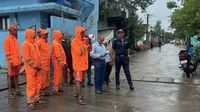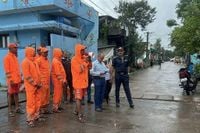As dusk fell over India’s eastern seaboard on October 28, 2025, an anxious calm settled in the coastal states. Cyclone Montha, swirling ominously over the Bay of Bengal, was bearing down on the port city of Kakinada in Andhra Pradesh, threatening millions with lashing winds and torrential rain. The country’s authorities, bracing for the worst, had already swung into action: schools and colleges were shuttered, tens of thousands evacuated, and an entire region placed on high alert.
The Indian Meteorological Department (IMD) had been tracking Montha’s path for days, issuing repeated bulletins as the storm intensified into a severe cyclonic storm. By Tuesday evening, Montha hovered just 160 kilometers (about 99 miles) southeast of Machilipatnam, its winds expected to reach sustained speeds of 90 to 110 kilometers per hour (55 to 68 mph) as it barreled toward land. According to Sky News, meteorologists anticipated landfall near Kakinada—home to nearly 400,000 people—by nightfall, a forecast that triggered a massive mobilization of disaster relief resources across the region.
Red alerts—the highest level of warning—were issued for 19 districts in Andhra Pradesh, with the IMD forecasting “extremely heavy rains” and the potential for widespread flooding. Neighboring states Tamil Nadu, Telangana, Kerala, and Karnataka, though not in the direct path, were also placed on alert for moderate to heavy downpours. The threat was not limited to rain: authorities warned fishermen to stay ashore, and the usually bustling fishing harbors fell eerily silent as boats were moored far from the churning surf.
The scale of the evacuation effort was staggering. Disaster teams in Andhra Pradesh moved at least 38,000 people from low-lying, flood-prone areas into relief camps, according to state officials cited by The Independent. In Odisha, another 32,000 residents were relocated as the storm’s outer bands began lashing the coast. The Andhra Pradesh government estimated that as many as four million people were living in vulnerable zones likely to be affected by the cyclone—a population larger than some small countries.
To accommodate the displaced, authorities prepared 1,906 relief camps and 364 school shelters across 1,238 villages, as Andhra Pradesh’s minister for communications, Nara Lokesh, announced on social media. “Evacuation of people from near the coast in Kakinada district has already started,” a disaster management official confirmed to The Independent. The government cancelled holidays for emergency staff, and in the city of Visakhapatnam, security personnel and swimmers were deployed at four beaches as a precautionary measure.
Schools and colleges across the coastal districts were ordered to remain shut until at least October 29, and public transport was thrown into disarray. The East Coast Railway, which serves major parts of Odisha and northern Andhra Pradesh, cancelled several trains, while flight services faced partial disruptions. The shutdown extended to everyday life: shops closed early, streets emptied, and families huddled in makeshift shelters, waiting for news.
Odisha’s administration, aiming for a “zero casualty” outcome, worked to move not only people but also livestock to safety, emphasizing the region’s hard-earned expertise in disaster management. The memory of October 1999—when a super cyclone killed around 10,000 people in Odisha—still loomed large. More recently, 2023 marked India’s deadliest cyclone season in years, with 523 deaths and damages estimated at $2.5 billion, according to the Associated Press.
While Montha’s fury was focused on Andhra Pradesh and Odisha, its impact rippled far beyond. The IMD issued orange alerts, the second-highest warning, for parts of Tamil Nadu, Rayalseema, and Puducherry, warning of heavy rains and strong winds. Several other states—Madhya Pradesh, Maharashtra, Bengal, Gujarat, Karnataka, Kerala, Rajasthan, and Goa—were placed on yellow alert for rainfall, a testament to the storm’s sprawling reach.
India’s vulnerability to cyclones is nothing new. The country’s east coast is battered by several such storms every year, particularly between April and December, and the population has learned to live with the annual threat. But scientists warn that the stakes are rising. Severe storms are becoming more frequent and intense in South Asia, a trend climate experts attribute to global warming and the warming of the oceans.
“Global warming is increasing the air temperature and is also making oceans warm. And if an ocean is very warm, it is going to supply a lot of energy to any tropical storm over the ocean,” meteorologist Akshay Deoras of the University of Reading told the Associated Press. As oceans absorb more heat, storms like Montha are expected to intensify more rapidly and unpredictably, posing greater risks to densely populated coastal regions.
India, now the world’s most populous country, finds itself on the frontlines of this climate crisis. It is among the highest current emitters of planet-heating gases, and its exposure to cyclones, floods, and heatwaves is only increasing. In 2024 alone, Asia recorded 167 disasters—the highest of any continent—leading to losses of over $32 billion, according to the Emergency Events Database maintained by the University of Louvain in Belgium. The toll is not just economic: each disaster tests the resilience of millions of families, many of whom have little to fall back on when disaster strikes.
The human stories behind these numbers are often ones of resilience and adaptation. In Andhra Pradesh, families packed their belongings and made their way to relief camps, often with little more than the clothes on their backs. Fishermen, whose livelihoods depend on the sea, watched the waves with a mixture of fear and resignation, hoping that the storm would pass quickly and spare their boats. Local officials, disaster response teams, and volunteers worked around the clock, coordinating evacuations, distributing food and water, and offering reassurance in the face of uncertainty.
As the night wore on and Montha’s winds howled ashore, the effectiveness of these preparations would be put to the test. For many, the hope was simple: that the lessons of past disasters, the swift mobilization of resources, and the determination of communities would be enough to weather yet another storm.
The arrival of Cyclone Montha serves as a stark reminder of the mounting risks faced by India’s coastal populations. As climate change accelerates, the challenge of protecting millions from the fury of nature will only grow more urgent—and the country’s response will continue to be watched by the world.

